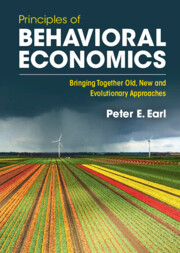Book contents
- Principles of Behavioral Economics
- Principles of Behavioral Economics
- Copyright page
- Contents
- Figures
- Tables
- Preface
- Acknowledgments
- 1 What Is Behavioral Economics?
- 2 What Motivates Us?
- 3 Why Is Life So Full of Problems for Us to Try to Solve?
- 4 How Do We Acknowledge Problems and Assess Options?
- 5 How Do We Deal with Uncertainty and Ambiguity?
- 6 How Do We Search for Solutions to Problems?
- 7 Why Do Some Things Matter More Than Others?
- 8 How Do We Choose?
- 9 How Can Firms and Governments Influence Our Choices?
- 10 What Determines the Productivity of an Organization?
- 11 How Does the Competitive Process Work?
- 12 Are There Any Behavioral Insights for Macroeconomists?
- 13 Can We Be Happy without Destroying the Environment?
- References
- Index
7 - Why Do Some Things Matter More Than Others?
Published online by Cambridge University Press: 18 October 2022
- Principles of Behavioral Economics
- Principles of Behavioral Economics
- Copyright page
- Contents
- Figures
- Tables
- Preface
- Acknowledgments
- 1 What Is Behavioral Economics?
- 2 What Motivates Us?
- 3 Why Is Life So Full of Problems for Us to Try to Solve?
- 4 How Do We Acknowledge Problems and Assess Options?
- 5 How Do We Deal with Uncertainty and Ambiguity?
- 6 How Do We Search for Solutions to Problems?
- 7 Why Do Some Things Matter More Than Others?
- 8 How Do We Choose?
- 9 How Can Firms and Governments Influence Our Choices?
- 10 What Determines the Productivity of an Organization?
- 11 How Does the Competitive Process Work?
- 12 Are There Any Behavioral Insights for Macroeconomists?
- 13 Can We Be Happy without Destroying the Environment?
- References
- Index
Summary
This chapter questions whether evolution would have resulted in people inheriting the kinds of preference systems that economists normally assume, whose generic form offers little to explain responsiveness to price changes or what people mean if they say they “don’t like” something or “wouldn’t change for the world.” The chapter fills these gaps by exploring the relationship between cognitive rules and operating systems, emotions and values, via a novel extension of Kelly’s personal construct psychology, means-end-chain analysis, Hayek’s theory of the mind and the notion of brain plasticity, with the resulting synthesis providing foundations of the core modern behavioral notion of loss aversion as well as showing how people can change their minds through time even though they may have trouble accepting some new situations. This analysis centers on the complex cognitive architecture of the systems of thinking and neural networks that people build to make sense of the world, where change in one area may require collateral change elsewhere and the mind favors options that limit the amount of cognitive restructuring necessary to prevent reductions in its ability to make sense of the world.
Keywords
- Type
- Chapter
- Information
- Principles of Behavioral EconomicsBringing Together Old, New and Evolutionary Approaches, pp. 179 - 219Publisher: Cambridge University PressPrint publication year: 2022

